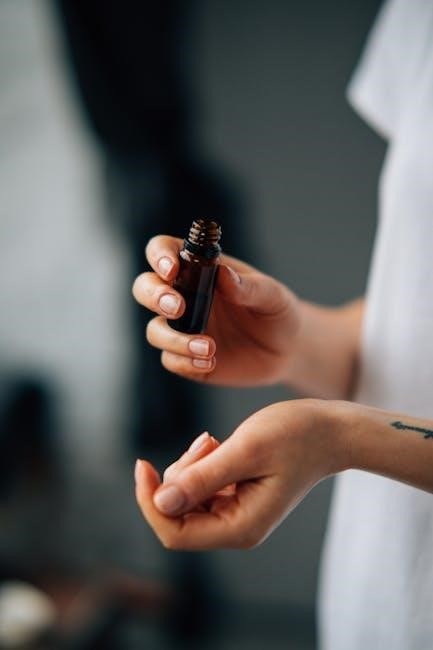Fluoride application involves applying a protective coating to teeth to prevent decay. It strengthens enamel, reduces sensitivity, and offers long-term protection. Fluoride varnish is a common, safe, and effective method.
1.1 What is Fluoride Varnish?
Fluoride varnish is a clear or colored protective coating applied to teeth to prevent decay and strengthen enamel. It contains sodium fluoride, which slowly releases fluoride ions to fortify tooth surfaces. The varnish is applied in a thin layer, adhering to teeth for extended protection. It is commonly used in dental and medical settings to treat conditions like tooth sensitivity and cavities. Fluoride varnish is safe for both children and adults, especially those at high risk of dental issues. Its application is quick, non-invasive, and effective, making it a popular choice for preventive dental care. It also hardens upon contact with saliva, ensuring long-lasting benefits.
1.2 Benefits of Fluoride Application
Fluoride application offers numerous benefits, primarily preventing tooth decay by strengthening tooth enamel and making it more resistant to acid attacks. It reduces tooth sensitivity, especially for individuals with exposed roots or worn enamel. Fluoride varnish also provides a protective barrier that helps prevent bacteria from causing cavities. Regular application can reverse early stages of tooth decay, promoting healthier teeth. Additionally, it is safe for both children and adults, making it a versatile solution for various dental needs. The varnish adheres to teeth, releasing fluoride slowly over time, ensuring prolonged protection. This method is also non-invasive and quick, making it a preferred choice for preventive dental care.

Pre-Application Preparation

Preparation involves gathering supplies like fluoride varnish, applicators, gloves, and a light source. Ensure the patient is ready, comfortable, and teeth are dry for application.

2.1 Necessary Supplies for Fluoride Varnish Application
Essential supplies include fluoride varnish, disposable applicators, gloves, and a light source for visibility. Additional items like gauze, mouth mirrors, and patient handouts are also recommended. These tools ensure a smooth and effective application process.
2.2 Preparing the Patient for Fluoride Treatment
Before applying fluoride varnish, explain the procedure to the patient to ensure understanding and cooperation. Ensure the teeth are clean and dry, as moisture can interfere with varnish adhesion. Remove any orthodontic appliances or dentures if necessary. Position the patient comfortably, ideally in an upright chair, to facilitate easy access to the teeth. Instruct the patient to avoid eating, drinking, or rinsing for at least 30 minutes post-application. For children, use simple language to reduce anxiety and consider using a mouth prop to keep the mouth open. Ensure all surfaces of the teeth are accessible for even application. Proper preparation ensures optimal results and patient comfort.

Step-by-Step Guide to Fluoride Varnish Application
Dry teeth thoroughly, apply a thin varnish layer, and allow it to dry before dismissing the patient. Follow all safety and post-care instructions carefully.
3.1 Drying the Teeth
Drying the teeth is a crucial step before applying fluoride varnish. Use a 2×2 gauze sponge to gently remove moisture and biofilm, ensuring better varnish adhesion. This step prevents the varnish from pooling and ensures an even coat. Proper drying also enhances the effectiveness of the fluoride treatment by allowing the varnish to set correctly. After drying, inspect the teeth to ensure they are moisture-free before proceeding with the application. This step is essential for maximizing the protective benefits of the fluoride varnish and ensuring its longevity on the tooth surfaces.
3.2 Applying the Varnish
Apply a thin, even layer of fluoride varnish using a small brush or applicator. Cover all tooth surfaces, ensuring complete coverage for optimal protection. The varnish should be applied sparingly to avoid pooling. Once applied, the varnish sets quickly upon contact with saliva, forming a protective film. Excess varnish can be gently removed with gauze if necessary. Proper application ensures the varnish adheres effectively, delivering fluoride to strengthen enamel and prevent decay. The process is straightforward, requiring attention to detail to achieve uniform coverage and maximize the treatment’s benefits. The varnish hardens rapidly, allowing patients to resume normal activities soon after application.
3.3 Allowing the Varnish to Dry
After applying the fluoride varnish, allow it to dry completely. The varnish typically sets within 10-15 seconds upon contact with saliva. Patients should avoid eating, drinking, or rinsing their mouth for at least 30 minutes to ensure proper adhesion. Keeping the mouth closed for a few minutes can help prevent disruption of the varnish. The film formed by the varnish hardens over time, providing a protective barrier. It is essential to avoid brushing or flossing for 4-6 hours to maintain the integrity of the varnish. Proper drying ensures the fluoride is effectively absorbed, maximizing its protective benefits for the teeth.
3.4 Post-Application Checks
After applying fluoride varnish, perform a visual inspection to ensure even coverage and proper adhesion. Check for any excess varnish that may need removal. Ensure the patient is comfortable and there are no signs of adverse reactions, such as swelling or difficulty breathing. Provide clear post-care instructions, emphasizing the importance of avoiding certain foods and oral hygiene practices for the recommended period. Schedule a follow-up if necessary to monitor the effectiveness of the treatment. These checks help ensure the varnish remains effective and the patient experiences no complications, promoting optimal dental health outcomes.

Post-Application Care Instructions
After fluoride application, avoid hard foods and hot drinks for 4-6 hours. Do not brush or floss for at least 4 hours. Resume normal care thereafter.
4.1 Immediate Aftercare
Immediately after fluoride varnish application, patients should avoid brushing or flossing their teeth for at least 4-6 hours to allow the varnish to set properly. Hard or crunchy foods, as well as hot drinks, should be avoided for the same duration to prevent chipping or melting the varnish. Patients can, however, eat soft foods and drink cool or room-temperature liquids if needed. The varnish hardens quickly upon contact with saliva, so individuals can resume normal activities shortly after the procedure. It’s important to follow these guidelines to ensure the varnish adheres effectively and provides maximum protection against tooth decay.
4.2 Dietary Restrictions
After fluoride varnish application, certain dietary restrictions are essential to maintain the integrity of the varnish and ensure its effectiveness. Patients should avoid consuming hard, crunchy, or sticky foods for at least 4-6 hours, as these can dislodge the varnish. Hot beverages and foods should also be avoided during this period, as they can soften the varnish. Additionally, sugary and acidic foods or drinks should be minimized to reduce the risk of tooth decay. It is recommended to stick to soft, non-abrasive foods and cool or room-temperature liquids. Avoiding alcohol-based mouthwashes and refraining from tobacco use can further support oral health. Adhering to these guidelines helps maximize the protective benefits of the fluoride varnish.
4.3 Oral Hygiene After Application
After fluoride varnish application, it is crucial to follow specific oral hygiene practices to ensure the varnish remains effective. Patients should avoid brushing or flossing their teeth for at least 4-6 hours after the treatment. When resuming oral hygiene, a soft-bristled toothbrush and fluoride-free toothpaste are recommended to prevent varnish removal. Gentle brushing and flossing can be gradually introduced, but excessive force should be avoided. For children, parents should supervise their oral hygiene routine to ensure compliance. Additionally, fluoride-containing toothpaste should be avoided for 24 hours post-application to allow the varnish to adhere properly. Proper oral hygiene practices support the long-term benefits of fluoride varnish in preventing tooth decay and strengthening enamel.
4.4 Duration of Protection
The protective effects of fluoride varnish can last several months, depending on factors like oral hygiene and diet. Typically, the varnish provides protection for 4-6 months, during which it gradually releases fluoride to strengthen tooth enamel. For optimal results, patients should avoid consuming hard, crunchy, or hot foods shortly after application to prevent varnish chipping. Regular dental check-ups and reapplication as recommended by a dentist are essential to maintain continuous protection. The longevity of fluoride varnish makes it a highly effective and convenient option for preventing tooth decay and promoting oral health.

Safety Considerations
Fluoride varnish is generally safe but may cause rare adverse reactions like dyspnea in asthmatic patients or edematous swellings. Use as directed to minimize risks.
5.1 Contraindications for Fluoride Varnish
Fluoride varnish is contraindicated in cases of ulcerative gingivitis, stomatitis, or active oral infections. Patients with known allergies to fluoride or varnish components should avoid treatment. It is also not recommended for individuals with severe dental sensitivity or those who have recently undergone certain dental procedures. Additionally, caution is advised for asthmatic patients, as rare cases of dyspnea have been reported. Fluoride varnish should not be applied to patients with extensive oral lesions or those who cannot tolerate the varnish’s texture. Special consideration is needed for pregnant or breastfeeding women, though varnish is generally safe in these cases. Always consult a healthcare provider before application.

5.2 Adverse Reactions to Fluoride Application
Adverse reactions to fluoride varnish are rare but may include mild side effects. Dyspnea, or labored breathing, has been reported in asthmatic patients, though this is extremely rare. Edematous swellings, or localized swelling, can occur in rare instances, particularly after extensive application. Nausea may also develop, especially if large areas are treated. These reactions are typically mild and temporary. In cases of excessive varnish ingestion, gastrointestinal discomfort may occur. If adverse effects persist or worsen, patients should consult their dentist or healthcare provider. Proper application and adherence to instructions minimize the risk of such reactions. Always inform your dentist of any allergies or medical conditions before treatment.

Special Cases
Fluoride application is crucial for children and high-risk patients. Children often require tailored approaches to ensure safety and efficacy. High-risk patients benefit from more frequent treatments.
6.1 Fluoride Application in Children
Fluoride varnish application in children is tailored to their age and tooth development. It is a safe, non-invasive procedure that strengthens enamel and prevents decay. For young children, the process is often stress-free, with minimal preparation required. Parents are advised to ensure the child avoids eating or drinking for 30 minutes post-application. The varnish is applied thinly to all tooth surfaces, adhering easily even on moist teeth. Post-application, children should avoid hard or crunchy foods for 4-6 hours. This method is highly effective for children at high risk of cavities, offering long-term protection. Proper adherence to post-care instructions ensures optimal results and lasting benefits.
6.2 Fluoride Application for High-Risk Patients
High-risk patients, such as those with frequent cavities or compromised enamel, benefit significantly from fluoride varnish application. The procedure is quick and non-invasive, making it ideal for sensitive individuals. For high-risk patients, fluoride varnish is applied in a thin, even layer to all tooth surfaces. Post-application instructions emphasize avoiding hard or crunchy foods for 4-6 hours and refraining from brushing or flossing for at least 24 hours. This ensures the varnish adheres properly and maximizes its protective effects. Additionally, high-risk patients may require more frequent applications to maintain optimal tooth protection and prevent further decay, tailored to their specific needs and risk factors.

Equipment and Supplies
Fluoride application requires specific equipment and supplies, including fluoride varnish, disposable applicators, gloves, a light source, gauze, and a mouth mirror for effective treatment.
7.1 Recommended Tools for Application
The application of fluoride varnish requires specific tools to ensure a clean and efficient process. Essential items include a small brush or applicator for precise varnish placement, disposable gloves to maintain hygiene, and a light source, such as a headlamp or pen light, for clear visibility. Gauze or cotton squares are used to dry the teeth before application, ensuring the varnish adheres properly. A mouth mirror may be helpful for accessing all tooth surfaces; Additionally, a bib or paper towel can protect clothing from varnish stains. These tools collectively facilitate a smooth and effective fluoride varnish application procedure, minimizing waste and ensuring optimal outcomes for patients.
7.2 Storage and Handling of Fluoride Varnish
Proper storage and handling of fluoride varnish are crucial to maintain its effectiveness. It should be stored in a cool, dry place, away from direct sunlight and moisture, to prevent degradation. The varnish should be kept at room temperature, between 15°C and 30°C, to ensure its viscosity and adhesive properties remain consistent; Always check the expiration date before use and avoid using expired products. When handling, wear disposable gloves to prevent skin contact. After opening, reseal the container tightly to maintain hygiene and prevent contamination. Proper storage and handling ensure the varnish remains effective and safe for application, adhering to professional dental standards. Always follow the manufacturer’s guidelines for storage and disposal.
Fluoride application is a proven method to prevent tooth decay and strengthen enamel. By following proper preparation, application, and aftercare steps, the varnish provides long-lasting protection. Regular applications, especially for high-risk patients, significantly reduce the incidence of cavities. Parents and patients should adhere to post-application instructions to maximize effectiveness. Dental professionals play a key role in ensuring correct techniques and patient education. Overall, fluoride varnish is a safe, effective, and essential tool in preventive dental care, offering numerous benefits for oral health when applied correctly.
